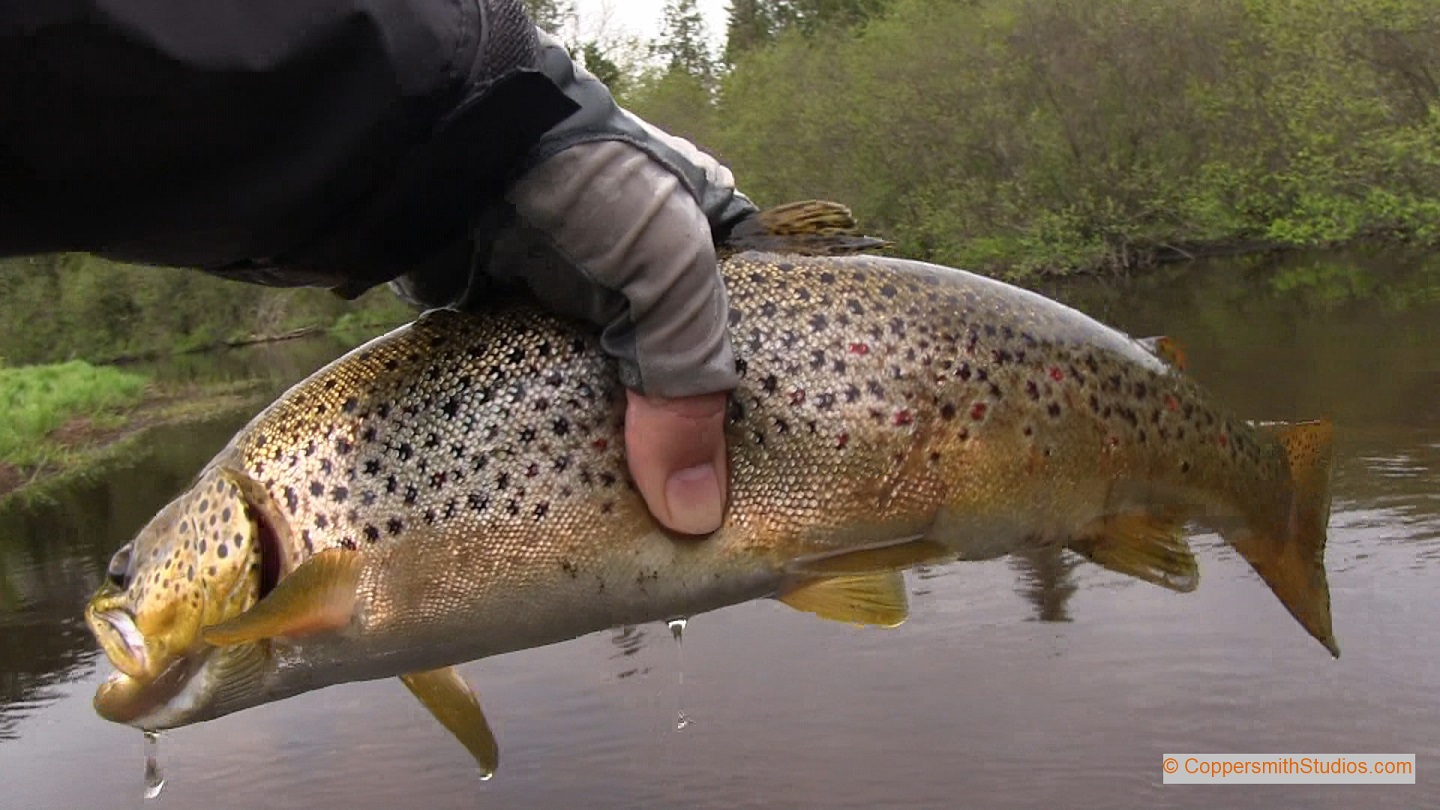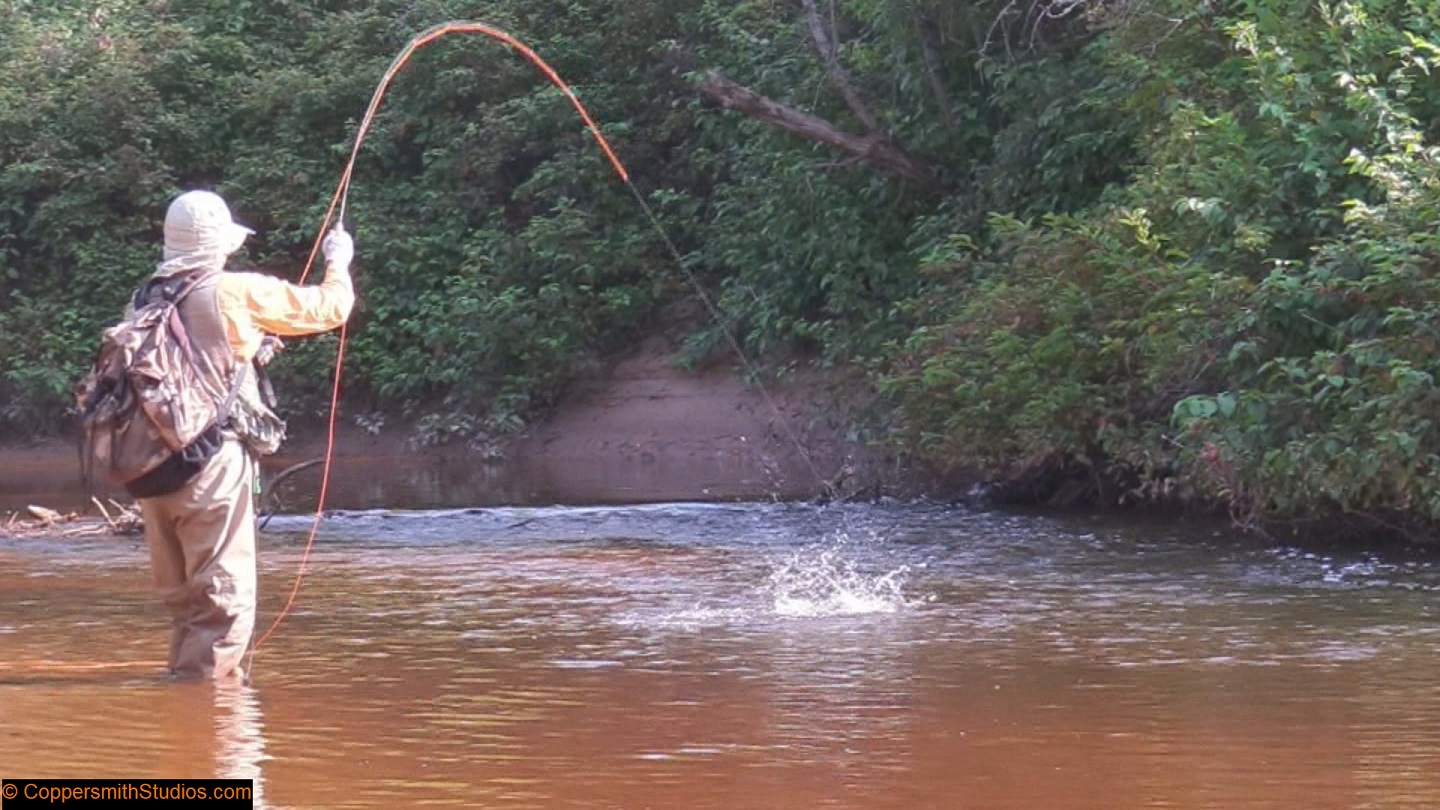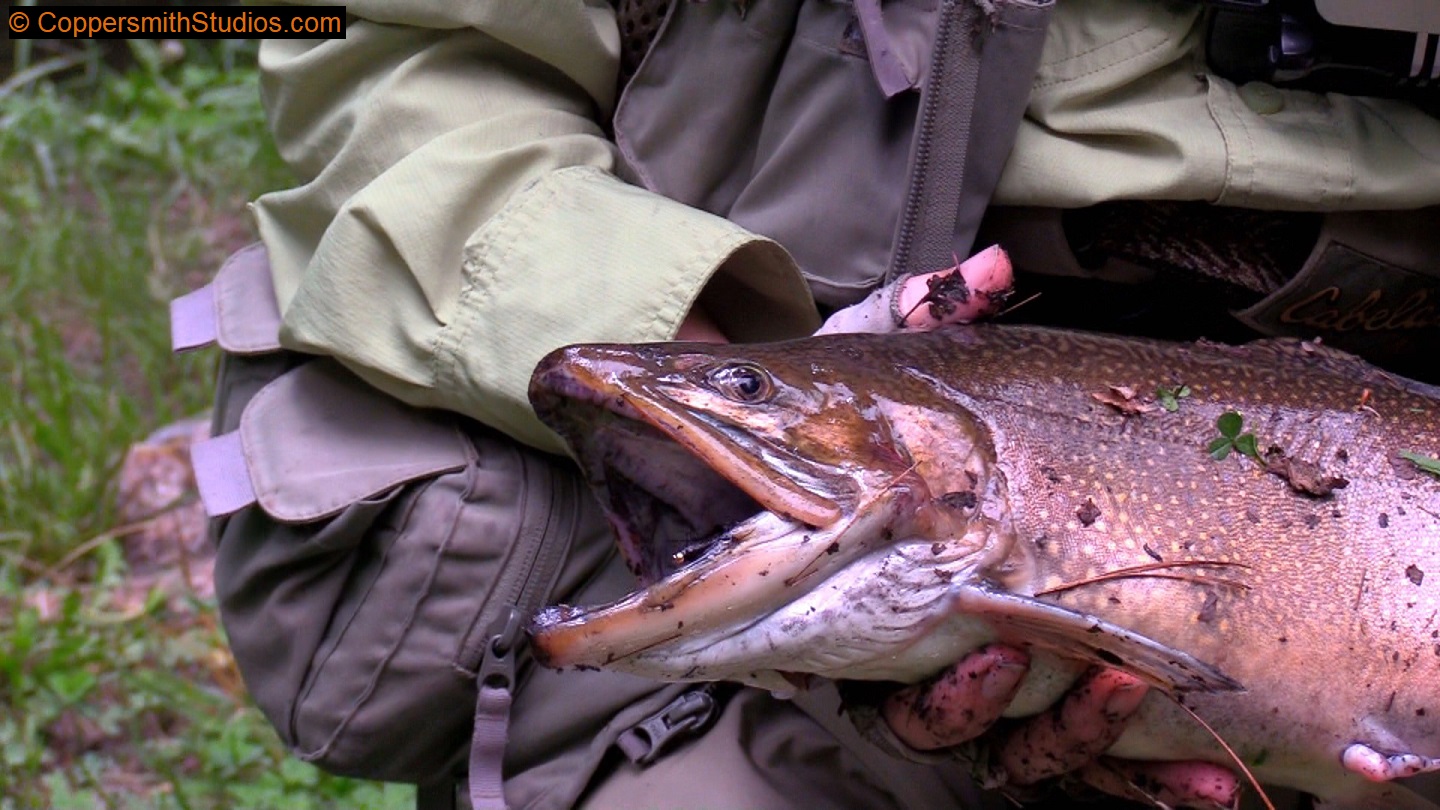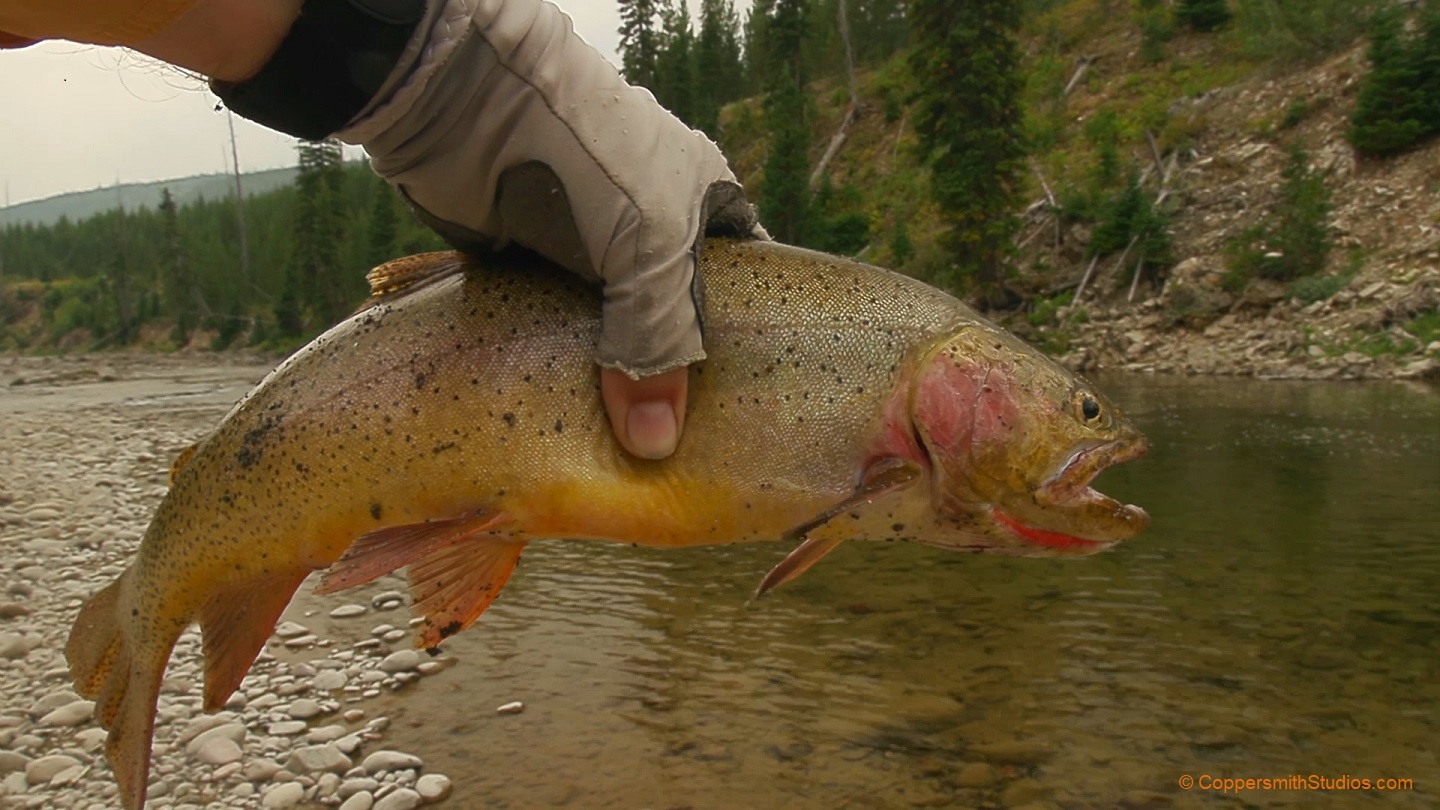 |
 |
 |
 |
 |
Stream via PATREON or CLICK BELOW TO PURCHASE.
DVD: How to Fly Fish with a Spinning Rod
DVD: Trout Streams of the Tetons
DVD: Trout Streams of Michigan, U.P. West
DVD: Trout Streams of North Carolina, West
DVD: Trout Streams of Virginia
DVD: Trout Streams of Southwest Wisconsin, North

Send Email to: CoppersmithStudios@gmail.com
To begin the process of ordering the world's best custom spin-fly rod send an email to CoppersmithStudios@gmail.com and ask to get in contact with Dan's custom rod builder. That is the only person currently authorized to use Dan's patented spin-fly rod design.
Spin-Fly Rods for SPIN CASTING Anglers
As I have made some improved developments in the design and use of spin-fly rods I thought it would be appropriate if I mentioned a few thoughts about fiberglass versus graphite as the base material to make a spin-fly rod. Way back in 1990 I converted from fiberglass spinning rods to graphite and for the next 30 years used only graphite for all of my rods, spinning or fly fishing. To my knowledge graphite was obviously better and my experience back in 1990 when I switched to graphite confirmed this. What I did not know is that during those 30 years engineers had made considerable progress in improving construction of fiberglass blanks and they now offer a compelling and different alternative to graphite.
My interest in fiberglass started with an innocent conversation with my custom rod builder, the guy I worked with to develop and refine my patented spin-fly rod design, regarding his recent fishing trip to the Wisconsin Driftless area. He told of many decent brown trout he caught. I asked if he was using one of his custom built rods and he replied of course, and it was a fiberglass one. I wondered, why on Earth would someone as knowledgeable as him, who could make a rod using any materials he wanted, fish with such an inferior instrument? What did he know about fiberglass that I did not? I had a follow up conversation with him about fiberglass and then did some research on-line. I eventually ordered 2 fiberglass rods from him as backups to my graphite rods. To my surprise, I ended up using those two fiberglass rods more often than my graphite ones. Fiberglass is not for everyone or all situations but there are times when it works really well and the intent of this article is to explain which situations are best for each type of rod.
First, let me describe the 4 rods being compared here. I have a 7.5' 4wt 4pc green graphite rod, a yellow 7.5' 4wt 4pc yellow fiberglass rod, a 6.5' 3wt 2pc orange graphite rod and a 7' 3wt 4pc orange fiberglass rod. I use all 4 rods for both fly fishing and spin fishing on small to medium sized streams. When fishing larger rivers I prefer to get out one of my 9' 5wt spin-fly rods which are made of graphite. I don't recommend fiberglass for fly rods over 7.5' or 4wt (8 pound line capacity) as they start to feel a little too heavy. Some people do prefer to use heavy duty fiberglass rods when targeting large fish but those people typically fish bait or troll and don't spend all day casting. My custom rod builder tells me if you spend more money you can get fiberglass rods of that size that are lighter than traditional fiberglass so that may be an option for some people.
Benefits of Fiberglass
1. You are less likely to get struck by lightning when using a fiberglass rod. They are not conductive to electricity. Of course your body still is so don't get too reckless out there. Graphite, on the other hand, is a good conductor of electricity and will basically function as a lightning rod. There have been days when using a fiberglass rod allowed me to continue fishing when otherwise I wouldn't and some of those days I ended up catching a lot of fish. Conversely, I have called it quits on days when fishing with a graphite rod when otherwise I would have kept fishing. By the way, you should also be aware that if you are within a 45 degree angle of the top of a tree the lightning will usually strike the tree before it strikes you.
2. Fiberglass fights large fish better. A fiberglass blank tends to arch more or less uniformly throughout its length. When fighting a heavy fish I feel like this gives me a larger cushion to maintain even pressure on the line so it doesn't break and doesn't get loose. For example, my fishing partner is a bit short and generally prefers and uses my small 6.5' 3wt graphite spin-fly rod. One day we fished a section of Utah's Provo River which is known to produce big brown trout. I told her she should use the 7' 3wt fiberglass rod instead, just in case a big one hits. That day she caught a 13", 14" and 15" brown trout on the fiberglass rod. Afterward she agreed the fiberglass rod did a better job of handling those larger trout than her usual graphite model.
3. Fiberglass is more durable than graphite. I recall catching the largest trout of my career in Montana's Flint Creek, a 21" brown, on my 7.5' 4wt graphite rod. It was a dramatic fight that I should have lost but got lucky and won. During the fight I recall my worries about the rod breaking. Perhaps I was a little paranoid. A couple years later I landed an 18" cutthroat trout in Colorado's South Fork Conejos River. That too was a dramatic fight that I should have lost but got lucky and won. I was using my 7.5' 4wt fiberglass rod and not for a second was I concerned about the rod breaking. There have also been times when hiking into rugged terrain that I choose fiberglass over graphite. I recall when fishing Adam's Fork in Colorado I slipped on a steep, rocky slope and rolled over my fiberglass rod. The rod had a few scratches on it but was otherwise undamaged. I don't know if a graphite rod would have survived. For the record, I have never had a graphite rod break while fighting a fish but I did have one break one day when I kept getting snagged and kept trying to yank my fly loose.
4. Fiberglass can be more accurate in casting. This depends on conditions and here I am specifically referring to spin-fly rods, especially when fished with a spinning real. Most of the flex of a graphite rod is in the upper 1/3 or 1/4th of the rod. A fiberglass rod has a flex which is distributed somewhat uniformly throughout its body. This results in a more steady tip. When fishing in spinning mode, using a lure with 1 or 2 flies trailing behind on their own leader, a steady tip improves accuracy. When I compare my 3wt graphite and fiberglass rods, the fiberglass has a much more steady tip. In fact, my 3wt 7' fiberglass spin-fly rod (which is a fly rod blank) has a more steady tip than my 7' ultralight graphite spinning rod and casts a lure and 2 flies more accurately than my 7' graphite spinning rod. When fishing small streams, which is the usual tendency with a 3wt, accuracy is more important than distance because there are snags all around. I never subjected my 3wt fiberglass spin-fly rod to the same metrics test used for the other rods but it definitely seems to cast lures farther than the graphite 3wt. Part of that may be due to the extra 6" of length.
5. Fiberglass can cast a dry fly more delicately than graphite. The casting speed of fiberglass is slower due to the slower flexing speed. This results in the dry fly landing more slowly and creating less of a splash on the water. Some dry fly purests use bamboo fly rods for this, which has the slowest casting speed of any rod type. Unfortunately such rods can cost $3000 to $5000 dollars. I personally don't worry too much about delicate casting, but if that is a feature you want you can get it much cheaper with fiberglass.
6. Fiberglass looks cool. This is purely subjective and depends on what particular model you use. My two fiberglass rods have a translucent quality and when the sun shines on them it looks a glass stained window commonly seen in churches. My yellow 4wt really glows in the sun. My orange 3wt is not so bright but does have a slight glow too. These rods are not painted so you don't have to worry about the paint wearing off.
Benefits of Graphite
1. Graphite is lighter. I can detect the difference with my two 3wt rods but as both are so light it does not have much effect on my experience. With the 4wt rods the difference in weight is more noticeable and some people might prefer graphite for that reason. When you throw in the weight of the reel and line and your arm I don't think it is that big of a deal. However, I would be hesitant to go above either a 4wt or longer than 7.5' in fiberglass mode. At that point I think the extra weight would be an annoyance to me. There are some types of fiberglass that are extra light but also extra expensive.
2. Graphite is stiffer. Not only does this affect the properties and performance of the rod but it also affects the feel. When you swing a graphite rod it obeys your command quickly. When I swing my 7.5' 4wt fiberglass I can sense a slight delay as the rest of the rod struggles to catch up. I personally enjoy the fast response of graphite. As the rods get shorter the response tends to be quicker and the differences are less noticeable. The slow response of my 7' 3wt fiberglass rod is hardly noticeable.
I used to think this stiffness translates into better hooksets. I was totally wrong. I had a long history of loosing large trout. One day when fishing Montana's South Fork Flathead River I hooked, fought and lost a 20" cutthroat trout on a graphite 6wt rod and the next day I hooked, fought and lost 13 cutthroats, up to 17", on my 4wt graphite rod. It was extremely upsetting. I finally realized I was never setting the hook properly. Since then I developed a hook setting process of not just moving my wrist up but pulling my whole arm back, like you are loading a bow and arrow. Since then the percentage of trout hooked that later got off has gone down to near zero. When I began using fiberglass spin-fly rods I continued with my aggressive hook setting technique and I have had the same landing success rate. I therefore cannot say the stiffness of graphite has impacted my hook setting ability for trout when using a spin-fly rod. On the other hand, if I were to fish for bass, pike or walleye with a spinning rod I would choose graphite because of its stiffness.
3. Graphite casts farther. As shown in my metrics chart, fiberglass will cast a 1/16th oz lure farther but graphite will cast lures of 1/8th oz or heavier farther. I use mostly 1/16th or 1/10th lures when fishing small to medium sized streams, so that works out well for me. However, when it comes to casting fly line, a graphite rod will cast farther than fiberglass - provided you have room for a decent backcast. Here is where it gets interesting. When fishing a small stream and you don't have room for a long backcast and you don't have a lot of fly line out you might find fiberglass casts farther. Graphite, being stiffer, needs a little more weight to load properly so it can spring back and fling the fly line forward. In small stream settings you don't always have enough fly line to load your rod properly. Some people compensate for this by putting a 4wt fly line on a 3wt graphite rod. That's called overloading. I used to do that myself. It worked OK except when I had room to make a long cast at which point it felt like the rod was being overworked. The heavier fly line also makes a louder splash which can put fish down. Fiberglass requires less weight to load properly and therefore tends to work better when casting with just a short fly line. This feature also helps fiberglass to rollcast better when using a short line. On the other hand, when fishing lakes, ponds or large streams, in either fly fishing or spin fishing mode, I would choose a graphite spin-fly rod over fiberglass.
4. Graphite is the default. If you are undecided in what type of material to use, go with graphite. Graphite is still the most common material used for fishing rods because it works so well.
When fishing a medium sized stream where only small trout are expected, I find myself choosing my graphite 4wt rod. The lightness makes the experience a little more sporting. When fishing a medium sized stream full of brown trout that range mostly in the 10" to 14" range with a larger fish always possible I find myself using my fiberglass 4wt. The pull of those heavier fish obscures the heaviness of the rod and I like how the rod handles those fish better with a deeper bend and more shock absorption.
When fishing a small sized stream with my 3wt I find myself using my 7' fiberglass most often. If the stream is really small and brushy I might go to the 6.5' graphite model due to its slightly smaller size. I've had a lot of fun with both rods, used either for fly fishing or spin fishing, and I can't say that one is better than the other. Perhaps it's the durability of the fiberglass that makes me prefer the 3wt.
Dan Coppersmith 04/12/2024
Created by: Dan Coppersmith 2024| www.CoppersmithStudios.com